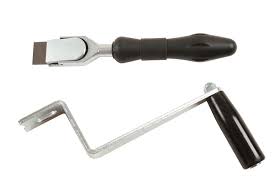The Importance of Choosing the Right Tool for the Job
Tools are an essential part of our daily lives, whether we realise it or not. From simple tasks like fixing a loose screw to complex projects that require specialised equipment, having the right tool for the job can make all the difference.
One of the key benefits of using the correct tool is efficiency. Trying to complete a task with the wrong tool can be frustrating and time-consuming. Not only does it waste time, but it can also lead to subpar results. By choosing the appropriate tool, you can work more effectively and achieve better outcomes.
Another advantage of selecting the right tool is safety. Using improper tools can pose serious risks, both to yourself and to others. For example, using a screwdriver as a chisel may result in injury or damage to materials. By using tools as intended, you minimise the chances of accidents and ensure a safer working environment.
Furthermore, having the right tool can save you money in the long run. While investing in quality tools may seem costly upfront, they are designed to last longer and perform better than cheaper alternatives. By choosing durable tools that are suited for their intended tasks, you reduce the need for frequent replacements and repairs.
In conclusion, selecting the right tool for any job is crucial for efficiency, safety, and cost-effectiveness. Whether you are a professional tradesperson or a DIY enthusiast, taking the time to identify and use appropriate tools will ultimately lead to better results and a more satisfying experience.
8 Benefits of Using the Right Tools for Enhanced Efficiency and Quality
- Tools help us complete tasks efficiently.
- Having the right tool can improve the quality of our work.
- Using tools correctly enhances safety in various activities.
- Tools enable us to tackle a wide range of projects and challenges.
- Investing in quality tools can save money in the long term.
- The right tool makes complex tasks more manageable.
- Tools empower individuals to be self-sufficient and independent.
- Proper tools increase productivity and effectiveness.
Five Drawbacks of Using Unsuitable Tools: From Inefficiency to Increased Costs
- Using the wrong tool can lead to inefficiency and frustration.
- Improper tools may pose safety risks and increase the likelihood of accidents.
- Low-quality tools may break easily, leading to additional expenses for replacements.
- Some tools require specific skills or training to use effectively, limiting their usability.
- Tools can take up space and require maintenance, adding to clutter and upkeep tasks.
Tools help us complete tasks efficiently.
Tools play a vital role in helping us complete tasks efficiently. By using the right tool for a specific job, we can streamline our workflow and achieve results in a more timely manner. Whether it’s a simple handheld tool or a complex piece of machinery, having the appropriate tool at hand allows us to work effectively and maximise productivity. The efficiency gained from using tools not only saves time but also enhances the quality of our work, making tasks more manageable and rewarding.
Having the right tool can improve the quality of our work.
Having the right tool at our disposal can significantly enhance the quality of our work. When we utilise tools that are specifically designed for the task at hand, we are able to work with precision and efficiency, resulting in a higher standard of output. The correct tool not only helps us to complete tasks more effectively but also ensures that the final results meet or exceed expectations. By investing in quality tools and using them appropriately, we can elevate the overall quality of our workmanship and achieve greater satisfaction in our accomplishments.
Using tools correctly enhances safety in various activities.
Using tools correctly enhances safety in various activities. By following proper tool usage guidelines and selecting the right tool for the task at hand, individuals can significantly reduce the risk of accidents and injuries. Whether it’s using a power drill with the appropriate safety precautions or handling sharp tools with care, understanding how to use tools safely is essential in ensuring a secure working environment. Proper tool handling not only protects individuals from harm but also minimises damage to materials and equipment, ultimately promoting a more efficient and secure work environment.
Tools enable us to tackle a wide range of projects and challenges.
Tools play a crucial role in empowering us to take on a diverse array of projects and overcome various challenges. Whether it’s a simple home repair task or a complex construction project, having the right tools at our disposal equips us with the capability to tackle tasks efficiently and effectively. With the versatility and functionality that tools provide, we are able to adapt to different situations and requirements, making it possible to accomplish a wide range of projects with confidence and precision.
Investing in quality tools can save money in the long term.
Investing in quality tools can prove to be a wise financial decision in the long term. While the initial cost may be higher compared to cheaper alternatives, high-quality tools are designed to be durable and reliable. By opting for quality tools, users can avoid frequent replacements and repairs, ultimately saving money over time. Additionally, these tools often perform better and more efficiently, leading to improved results and increased productivity. Therefore, prioritising quality when selecting tools can result in long-term cost savings and enhanced performance.
The right tool makes complex tasks more manageable.
Having the right tool at hand can significantly simplify and streamline complex tasks, making them more manageable and less daunting. A tool that is specifically designed for a particular job can help break down intricate processes into smaller, more achievable steps. By using the appropriate tool, individuals can work more efficiently, reduce errors, and ultimately achieve better results when tackling challenging projects.
Tools empower individuals to be self-sufficient and independent.
The use of tools empowers individuals to be self-sufficient and independent by enabling them to tackle tasks and projects on their own. With the right tools at their disposal, people can take control of various situations, whether it’s fixing a leaky faucet, assembling furniture, or maintaining their vehicles. This sense of self-reliance not only fosters a can-do attitude but also instils a sense of accomplishment and pride in one’s abilities. Tools serve as enablers that allow individuals to overcome challenges and obstacles independently, promoting personal growth and confidence in their skills.
Proper tools increase productivity and effectiveness.
Using the right tools can significantly enhance productivity and effectiveness in any task or project. When equipped with tools that are specifically designed for the job at hand, individuals can work more efficiently and achieve better results in a shorter amount of time. Proper tools streamline processes, reduce unnecessary effort, and enable tasks to be completed with precision and accuracy. Ultimately, investing in the right tools not only saves time but also improves overall performance and satisfaction with the outcome.
Using the wrong tool can lead to inefficiency and frustration.
Using the wrong tool for a task can result in inefficiency and frustration. When attempting to complete a job with an inappropriate tool, the process becomes more challenging and time-consuming. Tasks that could have been easily accomplished with the right tool may end up taking much longer, leading to frustration and potential errors. Inefficiency caused by using the wrong tool not only hampers productivity but also diminishes the quality of the final outcome, highlighting the importance of selecting the correct tool for each specific job.
Improper tools may pose safety risks and increase the likelihood of accidents.
Using improper tools can indeed pose significant safety risks and elevate the chances of accidents occurring. When tools are not designed for a specific task, they may not provide the necessary stability, precision, or durability required to complete the job safely. This can result in injuries to the user or others nearby, as well as damage to materials or property. It is crucial to always use tools as intended to minimise these risks and ensure a secure working environment.
Low-quality tools may break easily, leading to additional expenses for replacements.
Low-quality tools pose a significant disadvantage due to their tendency to break easily, resulting in the need for frequent replacements. This not only incurs additional expenses but also disrupts workflow and productivity. Investing in substandard tools may seem cost-effective initially, but the long-term consequences of constant replacements can outweigh any initial savings. It is essential to consider the durability and quality of tools to avoid unnecessary expenses and ensure efficient completion of tasks.
Some tools require specific skills or training to use effectively, limiting their usability.
Some tools pose a significant drawback in that they demand specific skills or training to wield effectively, thereby restricting their usability. This limitation can create barriers for individuals who may not have access to the necessary training or expertise required to operate these tools proficiently. As a result, the potential benefits of such tools may remain out of reach for many users, hindering their ability to leverage these resources to their full potential.
Tools can take up space and require maintenance, adding to clutter and upkeep tasks.
One drawback of tools is that they can contribute to clutter and maintenance responsibilities. Tools, especially a wide array of them, can occupy valuable space in a workshop or storage area, leading to a disorganised environment. Additionally, tools require regular maintenance to ensure they remain in good working condition, adding to the list of tasks that need to be completed. This upkeep can be time-consuming and may deter individuals from using their tools as frequently as needed due to the added effort required.
Tags: challenges, choosing, completing tasks efficiently, diverse projects, efficiency, enhance workmanship, importance, job, money saving, precision, productivity, quality of work, right tool, safety, satisfaction, secure working environment, tasks, tool, tool usage guidelines, tools, workflow
